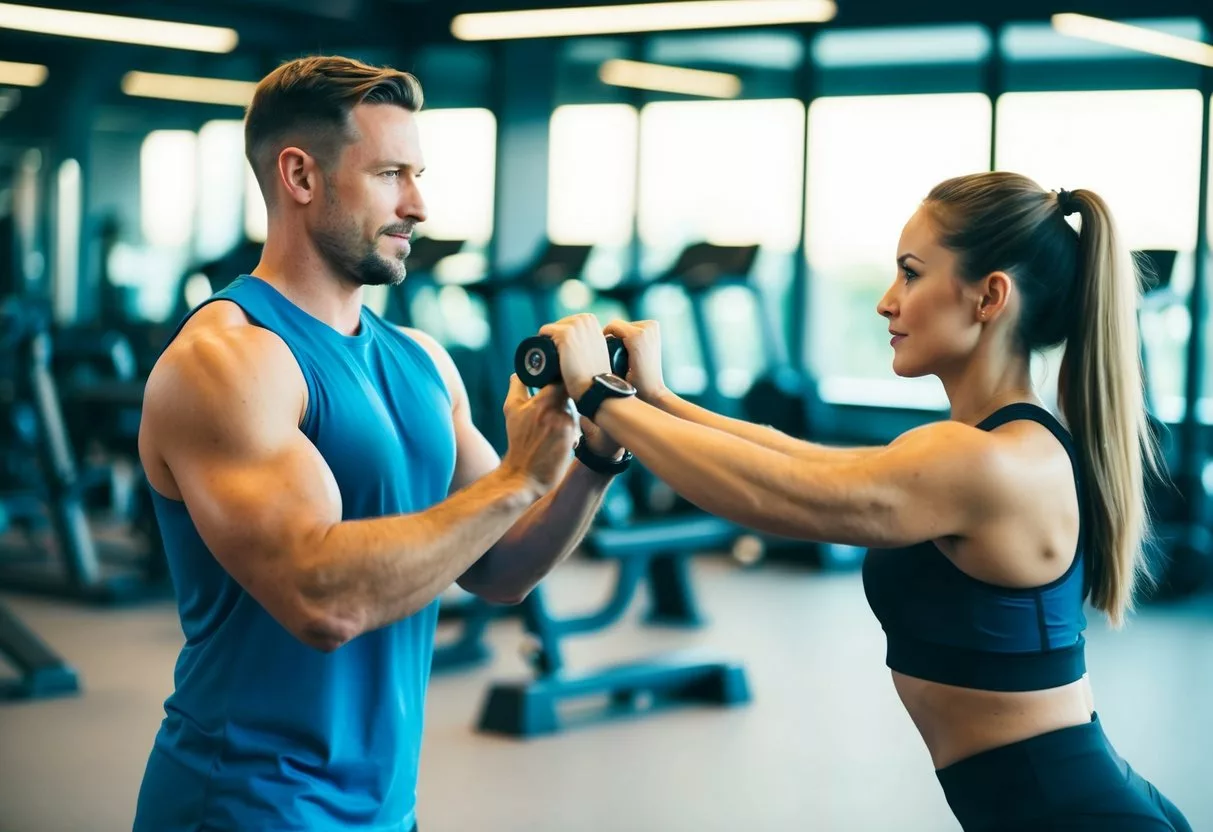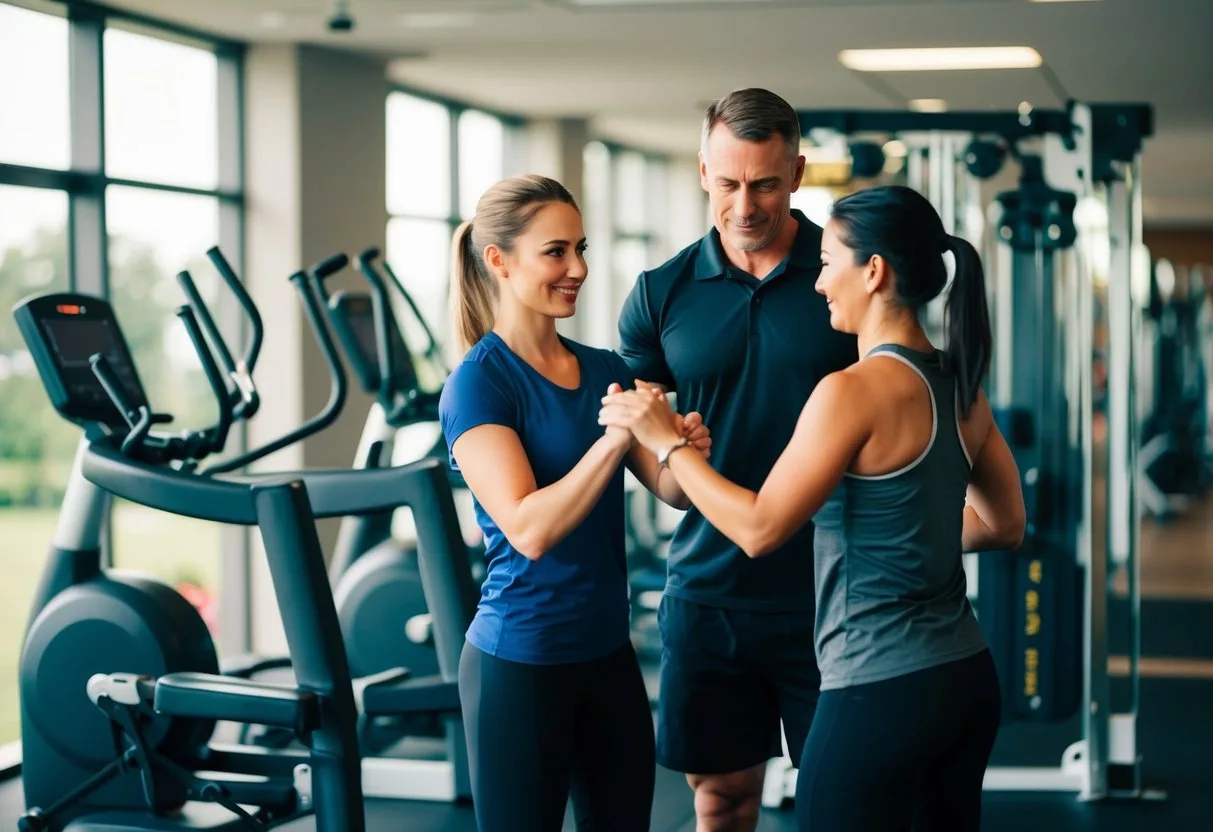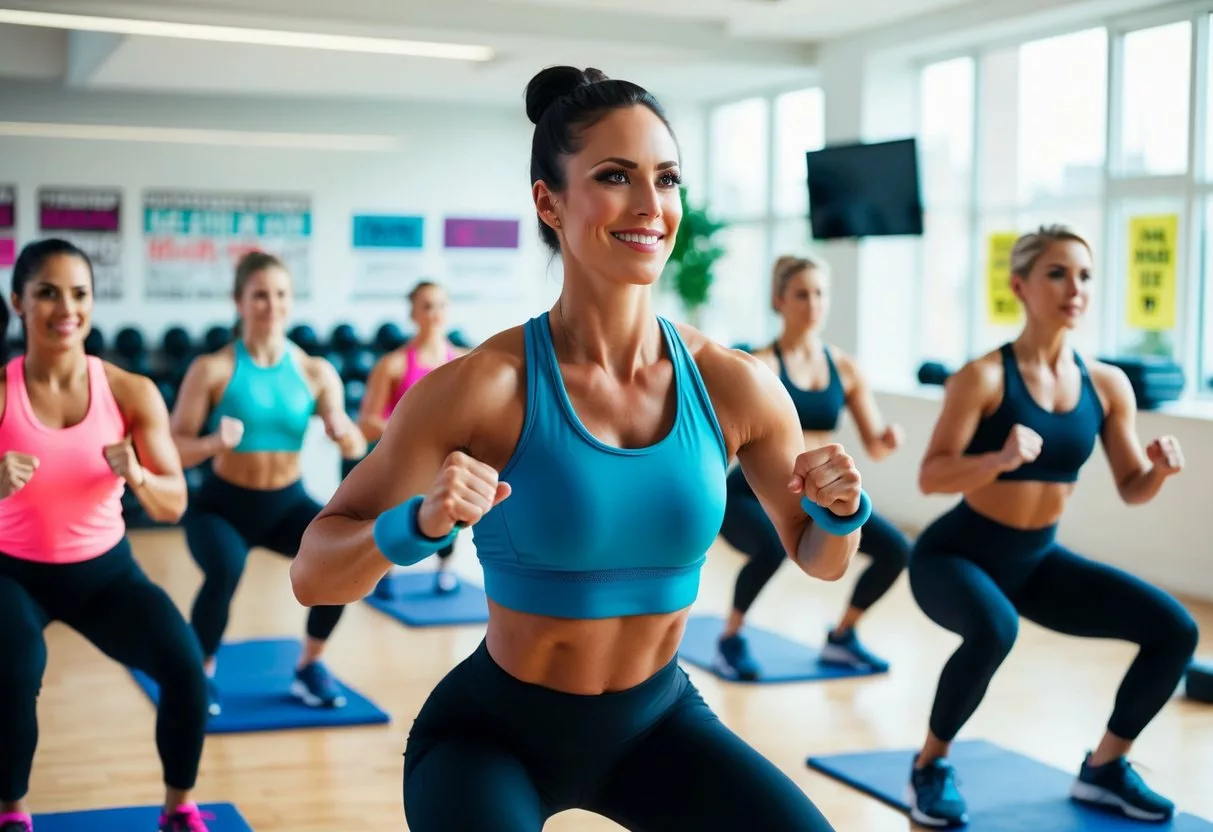Personal fitness training helps people reach their health and exercise goals. A trainer creates workout plans and guides clients through exercises. They teach proper form and give advice on diet and lifestyle.

A personal trainer is a fitness expert who designs safe, custom exercise programs to help people meet their health and fitness goals. They work with individuals or small groups. Trainers can work at gyms, fitness centers, or as independent contractors.
To become a trainer, a person needs to get certified. There are many certification programs to choose from. Top options include NASM, ACE, and ISSA. These programs teach about exercise science, nutrition, and how to work with clients. After getting certified, a trainer can start helping people improve their health and fitness.
The Role of a Personal Trainer

Personal trainers play a key part in helping clients reach their fitness goals. They assess needs, create custom workout plans, and provide guidance and support throughout the fitness journey.
Client Assessment and Goal Setting
Personal trainers start by evaluating each client’s fitness level. They check things like strength, flexibility, and stamina. They also talk with clients about their goals and any health issues.
Trainers use this info to set realistic targets. They might aim to help a client lose weight, build muscle, or boost endurance. Goals are often broken down into smaller, achievable steps.
Trainers also look at a client’s lifestyle and habits. They may suggest changes to diet or daily routines. This helps create a full plan for better health and fitness.
Creating Customized Exercise Programs
After assessment, trainers design personalized workout plans. These plans match each client’s goals, fitness level, and any physical limits.
A plan might include:
- Cardio exercises for heart health
- Strength training to build muscle
- Flexibility work to improve range of motion
Trainers adjust plans as clients progress. They may add new exercises or increase difficulty. This keeps workouts challenging and effective.
Safety is a top concern. Trainers choose exercises that are safe for each client’s body and skill level.
Instruction and Motivation
Personal trainers teach proper form for each exercise. They show clients how to use gym equipment safely. Good form helps prevent injuries and makes workouts more effective.
Trainers also act as coaches. They push clients to work hard and stick to their plans. They offer praise for progress and tips to overcome setbacks.
Motivation is a key part of a trainer’s job. They help clients stay excited about fitness. This might mean changing routines or setting new goals to keep things fresh.
Trainers also teach clients about fitness and health. They share tips on nutrition, rest, and healthy habits. This helps clients make lasting changes for better health.
Certification and Education
Getting certified as a personal trainer involves completing an accredited program and passing an exam. There are several respected organizations that offer certifications. Ongoing education keeps trainers up-to-date on the latest fitness knowledge.
Personal Trainer Certifications Overview
To become a certified personal trainer, you need to complete a certification program. Top certifying bodies include ACE, NASM, ACSM, and NSCA. These programs teach exercise science, program design, and client assessment skills.
Most certifications require:
- High school diploma or equivalent
- CPR/AED certification
- Passing a certification exam
Exam topics often cover:
• Anatomy and physiology
• Exercise technique
• Program design
• Nutrition basics
• Client relations
Certification costs range from $500-$1000+ including study materials and exam fees. Programs typically take 3-6 months of study to complete.
NCCA-Accredited Certification Programs
NCCA-accredited certifications are considered the gold standard in the fitness industry. The National Commission for Certifying Agencies (NCCA) ensures programs meet high quality standards.
Top NCCA-accredited certifications include:
• ACE Certified Personal Trainer • NASM Certified Personal Trainer
• ACSM Certified Personal Trainer • NSCA Certified Personal Trainer
These programs offer comprehensive study materials, practice exams, and hands-on training options. Certifications are valid for 2-3 years before renewal is required.
Many gyms and fitness centers prefer or require NCCA-accredited certifications when hiring trainers.
Continuing Education and Specializations
Personal trainers must complete continuing education units (CEUs) to keep certifications current. CEUs can be earned through workshops, conferences, online courses, and specialty certifications.
Popular specializations include:
• Strength and conditioning • Corrective exercise • Group fitness instruction • Sports performance • Senior fitness
Specializations allow trainers to work with specific populations or offer unique services. They also increase a trainer’s marketability and earning potential.
Many certifying bodies offer their own specialty courses and certifications. Trainers can also seek education from other respected fitness organizations.
Fitness and Exercise Science

Fitness and exercise science form the foundation of effective personal training. These fields provide crucial knowledge for trainers to design safe and effective workout programs.
Understanding Human Anatomy in Fitness
Trainers need to know the human body’s structure and function. This includes bones, muscles, and joints.
Skeletal muscles are key in fitness. They connect to bones via tendons and enable movement. Major muscle groups include:
- Chest (pectorals)
- Back (latissimus dorsi)
- Shoulders (deltoids)
- Arms (biceps, triceps)
- Legs (quadriceps, hamstrings)
Knowing muscle origins, insertions, and actions helps trainers choose exercises. It also aids in explaining movements to clients.
The cardiovascular and respiratory systems are vital too. They supply oxygen and nutrients to working muscles during exercise.
Exercise Physiology and Program Design
Exercise physiology examines how the body responds to physical activity. It covers energy systems, metabolism, and adaptations to training.
Three main energy systems fuel exercise:
- ATP-PC system (quick, intense bursts)
- Glycolytic system (moderate intensity, short duration)
- Oxidative system (low intensity, long duration)
Understanding these systems helps trainers design effective workout plans. They can tailor programs to client goals and fitness levels.
Program design involves selecting exercises, sets, reps, and rest periods. It also includes progressive overload to ensure continued improvement.
Trainers must consider factors like:
- Client’s fitness level
- Goals (strength, endurance, weight loss)
- Time available
- Equipment access
Injury Prevention and Management
Injury prevention is a key aspect of personal training. Trainers must prioritize client safety in all workout plans.
Proper form and technique are crucial. Trainers should teach and monitor correct movement patterns. This reduces the risk of injuries from poor form.
Warm-ups and cool-downs are important. They prepare the body for exercise and aid recovery. A good warm-up includes:
- Light cardio
- Dynamic stretching
- Movement-specific exercises
Trainers should know common exercise-related injuries. These include sprains, strains, and overuse injuries. They must be able to spot early warning signs.
If injuries occur, trainers need to know basic first aid. They should also refer clients to medical professionals when needed.
Nutritional Guidance for Optimal Performance
Proper nutrition plays a key role in fitness success. It fuels workouts, aids recovery, and helps clients reach their goals. Working with a certified nutrition coach can take results to the next level.
Role of Nutrition in Fitness
Nutrition is essential for optimal fitness performance. It provides energy for workouts and helps build muscle. A balanced diet with the right mix of carbs, protein, and healthy fats is crucial.
Carbs fuel exercise and help maintain blood sugar. Protein aids muscle repair and growth. Healthy fats support hormone function.
Proper hydration is also vital. Water regulates body temperature and transports nutrients. Dehydration can harm performance and recovery.
Timing of meals matters too. Eating before workouts provides fuel. Post-workout nutrition helps muscles recover and grow.
Certified Nutrition Coach Importance
A certified nutrition coach can create personalized meal plans. They consider a client’s goals, food preferences, and lifestyle.
These experts stay up to date on the latest nutrition research. They can debunk diet myths and provide science-based advice.
Nutrition coaches help with portion control and mindful eating. They teach clients how to make healthy choices when dining out.
They also assist with weight management strategies. This may include calorie tracking or meal prep tips.
A coach provides accountability and support. They can adjust plans as needed to ensure continued progress.
Client Interaction and Behavioral Coaching

Personal trainers need skills beyond just fitness knowledge. They must work closely with clients and help them change habits.
Building Strong Client Relationships
Trainers should start by getting to know each client well. They can ask about fitness goals, health history, and daily routines. This helps create a personalized training plan.
Good communication is key. Trainers need to listen and offer support. They should celebrate small wins to keep clients motivated. Regular check-ins help track progress and adjust goals.
Clear boundaries are important too. Trainers should set rules about scheduling, payments, and appropriate contact. This keeps the relationship professional.
Behavioral Coaching Techniques
Behavioral coaching helps clients stick to their fitness plans. Trainers can use methods like goal-setting and positive reinforcement.
They might help clients break big goals into smaller steps. This makes change feel more doable. Trainers can also teach clients to track their habits. This builds awareness of both good and bad behaviors.
Motivational interviewing is another useful tool. It involves asking open questions to help clients find their own reasons to change. This can be more effective than just telling them what to do.
Trainers should also be ready to help clients overcome setbacks. They can teach ways to handle stress and build new habits.
Career in Fitness Training

A career in fitness training offers diverse job opportunities and the potential for good earnings. Success in this field depends on building and keeping a strong client base.
Job Opportunities and Earning Potential
Fitness professionals can work in many settings. These include gyms, health clubs, and private studios. Some trainers offer home visits or outdoor training sessions.
Personal trainers with certifications can earn about 20% more than those without. This shows the value of getting certified.
Pay varies based on location, experience, and client type. Entry-level trainers might earn around $30,000 per year. Experienced trainers in high-end gyms can make over $100,000 annually.
Some trainers choose to specialize. They may focus on areas like sports performance, weight loss, or rehabilitation. Specializing can lead to higher pay and more job options.
Building and Maintaining Clientele
Getting clients is key for fitness trainers. Many start by working for a gym to gain experience and contacts.
Trainers need strong people skills. They must motivate clients and keep them engaged. Building trust and rapport is crucial for client retention.
Marketing is important for attracting new clients. Trainers can use social media, local advertising, and word-of-mouth referrals.
Online training has grown in popularity. Many trainers now offer virtual sessions. This can expand their client base beyond their local area.
Continuing education helps trainers stay current. It allows them to offer the latest training methods and nutrition advice. This keeps clients interested and coming back.
Understanding Fitness Training Environments

Fitness training environments play a big role in workout success. The setting affects motivation, equipment access, and training style. Different options suit different needs and goals.
Gyms vs. Private Studios
Gyms and health clubs offer a wide range of equipment and classes. They have cardio machines, weights, and group fitness rooms. Many people like the energy of working out around others.
Private studios provide a more personal feel. They often have fewer clients at once. This means more one-on-one time with trainers. Studios may focus on specific workout types like yoga or strength training.
Gyms tend to be cheaper but busier. Studios cost more but offer a quieter space. The choice depends on budget, comfort level, and fitness goals.
Online and Digital Training Platforms
Digital fitness options have grown popular. They let people work out from home or anywhere with internet access. Many platforms offer live classes and on-demand workouts.
These services often cost less than in-person training. They provide flexibility in scheduling. Users can choose from various workout styles and trainers.
Some platforms use AI to create custom workouts. Others focus on community support through online groups. The downside is less hands-on help with form and technique.
Digital training works well for self-motivated people. It’s also good for those with busy schedules or limited access to gyms.
Training Methodologies and Styles

Personal fitness training offers diverse approaches to help people reach their goals. The choice of method depends on individual needs, preferences, and fitness levels.
Group Fitness vs. Individual Training
Group fitness classes bring people together to work out. These classes often focus on cardio, strength, or flexibility. They can be fun and motivating.
Individual training gives one-on-one attention from a trainer. This allows for personalized workouts and close form checking. It’s great for people with specific goals or health issues.
Both methods have pros and cons. Group classes are usually cheaper and offer social support. Individual training provides more focused attention but costs more.
Popular Training Techniques
Resistance band training is a flexible option for strength building. It’s portable and good for all fitness levels.
Pilates focuses on core strength and flexibility. It uses bodyweight exercises and sometimes special equipment.
CrossFit mixes high-intensity cardio with weightlifting. It aims to build overall fitness and strength.
Olympic weightlifting involves complex lifts like the snatch and clean and jerk. It builds power and strength.
Bodybuilding targets muscle growth and definition. It uses weight training and strict dieting.
Interval training alternates periods of hard work and rest. It’s great for boosting cardio fitness and burning calories.
Certification Process and Exam Preparation

Getting certified as a personal fitness trainer involves studying, preparing, and passing an exam. The process takes dedication but opens doors to a rewarding career helping others achieve their fitness goals.
Study Guides and Prep Courses
Personal trainer certification programs offer study materials to help candidates prepare. Many provide detailed manuals covering exercise science, program design, and client assessment.
Online courses let students learn at their own pace. Video lessons, practice quizzes, and interactive modules reinforce key concepts.
Some organizations offer weekend workshops for hands-on learning. These intensive sessions cover practical skills like exercise form and client communication.
Most programs recommend 60-70 hours of study time. This usually takes 1-3 months, depending on the student’s background and schedule.
Exam Strategies and Passing Tips
The certification exam tests knowledge across multiple domains. Questions cover anatomy, nutrition, program design, and professional conduct.
Exams may be taken online or at testing centers. They typically include 120-150 multiple-choice questions with a 2-3 hour time limit.
To pass, candidates should:
- Review practice tests to get familiar with question styles
- Focus on weak areas identified in practice exams
- Use mnemonic devices to remember key terms and concepts
- Get plenty of rest before exam day
- Read each question carefully and eliminate wrong answers
A passing score is usually around 70%. Some programs allow retakes if needed.
Health and Safety in Fitness Training
Safety is key in personal training. Trainers must be ready for emergencies and know how to keep clients safe. This means having the right skills and following strict safety rules.
CPR/AED Certification Requirement
Personal trainers need CPR and AED certification. CPR stands for cardiopulmonary resuscitation. It’s a lifesaving technique used when someone’s heart stops. AED means automated external defibrillator. This device can restart a heart.
Trainers learn these skills through special classes. They practice chest compressions and rescue breaths. They also learn how to use an AED safely. These certifications must be kept up to date.
Having these skills helps trainers act fast in an emergency. They can start CPR or use an AED while waiting for help to arrive. This quick action can save lives.
Emergency Protocols and Safety Procedures
Fitness centers and trainers must have clear emergency plans. These plans spell out what to do if someone gets hurt or sick. They cover steps like calling for help and using first aid.
Safety procedures are also crucial. Trainers check equipment before use. They teach clients how to use machines safely. They watch for signs of overexertion or injury.
Good trainers know their clients’ health history. They adjust workouts to avoid risks. They also keep the gym clean to stop the spread of germs.
Regular safety drills help everyone stay prepared. Quick action in an emergency can make a big difference.
Professional Development and Industry Insight
Fitness trainers need to keep learning and building connections to stay at the top of their game. This helps them give clients the best and newest workout advice.
Staying Current with Fitness Trends
Fitness professionals must keep up with new trends and research. They can do this by:
- Reading fitness magazines and blogs
- Attending workshops and seminars
- Taking online courses
Many certifying bodies require continuing education units (CEUs) for recertification. These units help trainers learn about new exercise methods and equipment.
Trainers should also try new workout styles themselves. This gives them first-hand experience to share with clients.
Networking and Community Engagement
Building a network is key for personal trainers. They can:
- Join professional fitness groups
- Attend industry events and conferences
- Connect with other trainers on social media
These connections help trainers share ideas and learn from others. They might find new job leads or client referrals too.
Trainers can also get involved in their local fitness scene. They could:
- Volunteer at community health events
- Lead free workout classes in parks
- Speak at local schools about fitness
This helps trainers build their reputation and find new clients.
Frequently Asked Questions
Personal trainers can help you reach your fitness goals. But it’s important to understand what to look for and expect when hiring one. Here are some key questions about personal training.
What qualifications should you look for in a personal trainer?
A good personal trainer should have proper certification from a respected organization. Look for certifications from NASM, ACE, or ACSM. They should also have experience working with clients who have similar goals to yours.
The trainer should know CPR and first aid. Ask about their education in exercise science or a related field.
How do you know if personal training is worth the investment?
Personal training can be worth it if you need motivation, guidance, and a custom plan. A trainer can teach proper form and push you to improve.
They can also help you avoid injury and plateau. If you’re not seeing results on your own, a trainer may get you back on track.
What is the average cost of hiring a personal trainer in a metropolitan area?
Personal training costs vary widely. In big cities, expect to pay $50-$150 per hour session. Some trainers offer package deals at lower rates.
Gym-based trainers may charge less than private trainers. Online training is often cheaper than in-person sessions.
What are the benefits of having a personalized fitness program?
A custom program targets your specific goals and fitness level. It can help you make faster progress than a generic plan.
Personalized programs account for injuries or health issues. They also change as you improve, keeping you challenged.
How often should you meet with a personal trainer to see results?
Meeting frequency depends on your goals and budget. Many people see results with 1-3 sessions per week.
Consistency is key. Even one session per week can help if you follow the trainer’s plan between meetings.
What is the difference in training with a certified personal trainer versus self-guided workouts?
A certified trainer provides expert guidance and motivation. They also create structured plans and teach proper form.
Self-guided workouts require more research and self-discipline. You may progress slower without expert feedback.
Trainers can spot and fix form issues that you might miss on your own. They also provide accountability to help you stay on track.